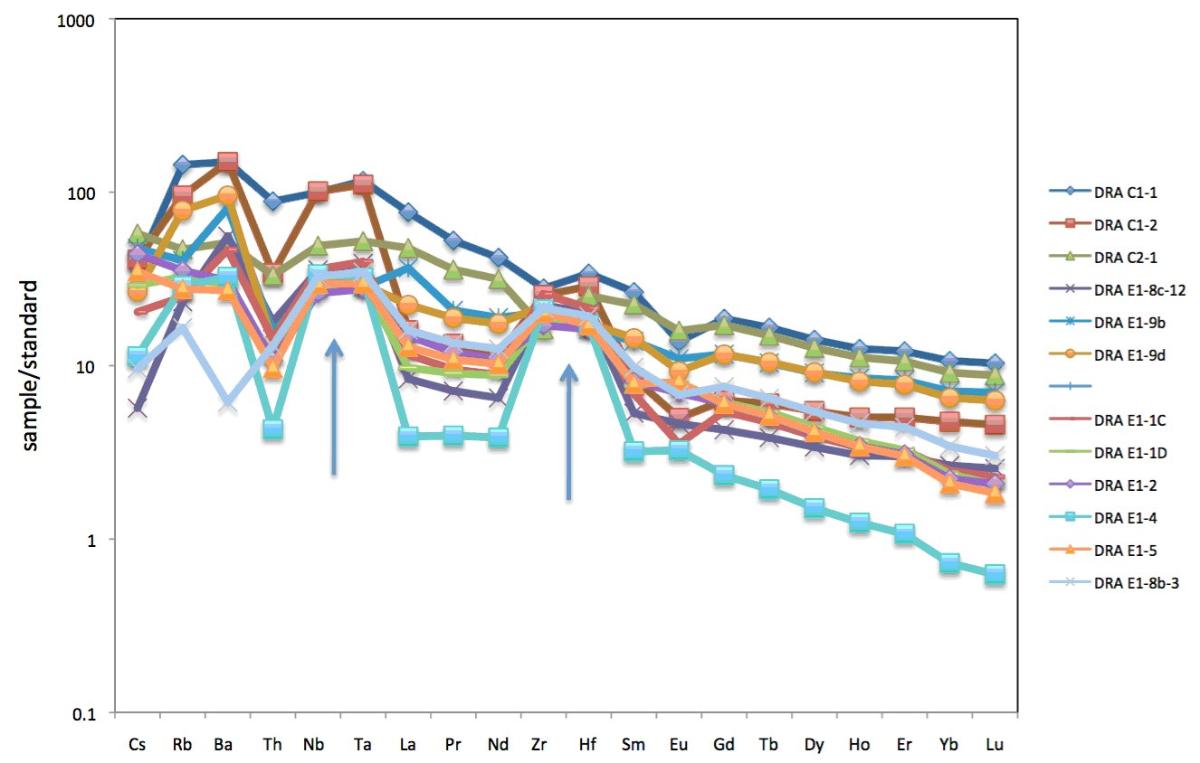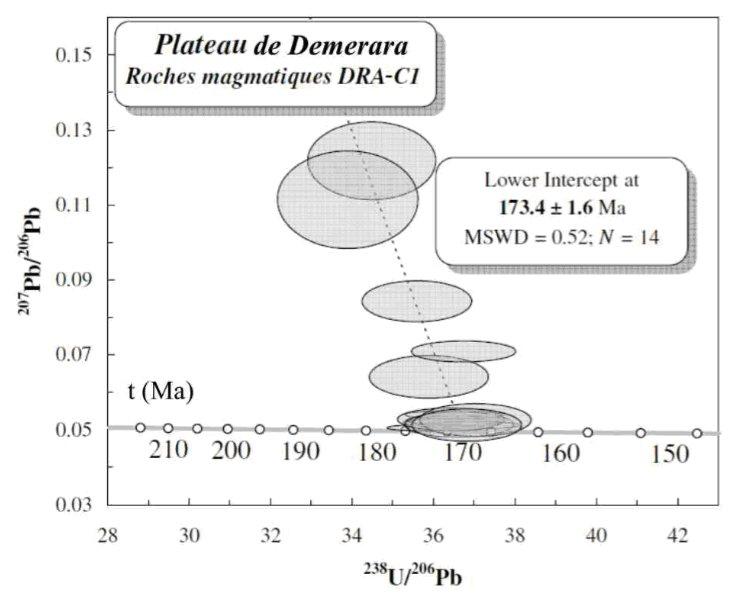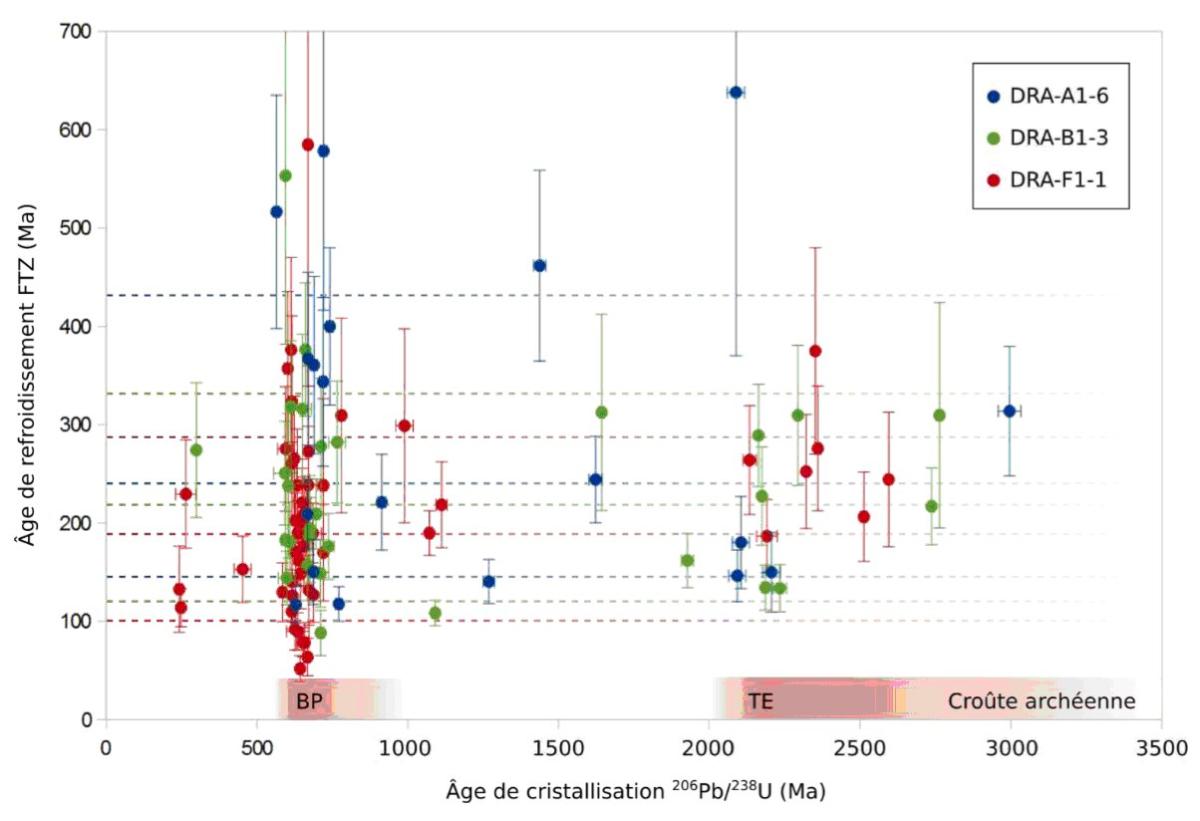During the DRADEM campaign, dredges sampled several part of the transform margin north of the Demerara plateau (Fig. 1). Bathymetric mapping confirmed the segmentation of the margin in three part, that were previously proposed by Loncke et al. (2015) and Mercier de Lépinay (2016) from seismic lines. The western part (Sites A, G and B) presents a steep and linear slope, without sedimentary cover. The eastern part (Sites C and E) presents several ridges, en échelon disposed. The central part (between Sites B and C) has a less steep slope, with a sedimentary cover, numerous canyons and traces of gravity-driven slides. Finally, Site F is a horst at the boundary between the North-Demerara transform margin and the East Demerara divergent margin. The bathymetry is related to the basement structure, which is inherited from the formation of the transform margin during the Cretaceous.

Figure 1 : bathymetric and structure map of the studied area. Dredge sites A to G are localized (Girault, 2017).
The main result of the campaign is the confirmation that the basement of the Demerara plateau is magmatic in nature. In three dredges were found basalts, trachy-basalts and rhyolites. These magmatic rocks exhibit similar geochemical patterns with hot-spot affinities (positive anomalies in Nb, Ta, Zr and Hf: Fig. 2). Rhyolites were dated at 173 Ma from micro-zircons (< 30 µm) (Fig. 3) (Basile et al., 2020).

Figure 2 : Trace elements diagram for the dredged magmatic rocks (A. Agranier)

Figure 3 : U/Pb dating of zircons in rhyolites from dredge C1 (J.L. Paquette)
Sedimentary rocks allowed us to locally make a reconstitution of the deposition environments, which were mainly shallow marine water, frequently in a carbonated shelf, sometimes above sea level, with significant detrital inputs. As most of these facies were not dated, they did not allow to reconstruct the evolution of sedimentation with time, nor the subsidence history. However, they suggest that the subsidence is very late (younger than normal faulting) in the evolution of the distal margin.
Zircon fission track analysis showed that the sampled sedimentary rocks were not heated in situ above 350°C. The cooling ages recorded by fission tracks are inherited from the erosion of the landscape that provided the detrital zircons. In each site, cooling ages are related to three geodynamical events: the post-orogenic erosion of the variscan belt (300-350 Ma), the erosion related to the uplift in the Central Atlantic Magmatic Province and the subsequent opening of the Central Atlantic (190-200 Ma), and the erosion associated with the opening of the Equatorial Atlantic (120 Ma) (Fig. 4). The main cristallization age of the zircon is related to the panafrican orogeny (600 Ma, Fig. 4), which is unknown in the Guyana cration, and should indicate a detrital source East of the plateau, probably in what is now the conjugated african margin.

Figure 4 : cristallization and cooling ages of detrital zircons (Girault, 2017). FTZ = zircon fission tracks; BP: brasiliano-panafrican orogenic cycle; TE: transamazonian-eburnean orogenic cycle.
Magnetic data acquired during the campaign were processed and compiled with data acquired during other academic campaigns (GUYAPLAC, IGUANES, MARGATS). This work has been funded by Total. It brings new insigths on the physical properties of the basement of the Demerara plateau. Magnetic anomaly underlines the boundary between the plateau and the adjacent abyssal plain, probably because the difference of nature. Smaller magnetic variations are also observed within the plateau, that might be related to basement heterogeneities.
These results were developped in two publications (Basile et al., 2020; and in preparation), that present their interpretation in the shape of the opening of the Central and Equatorial Atlantic. These results were also used in studies based on geophysical data (Museur et al., 2021; Biari et al., 2021) and in global (Loncke et al., 2020) or more local (Graindorge et al., 2020) reviews.
Cited references:
Basile Christophe, Girault Igor, Paquette Jean-Louis, Agranier Arnaud, Loncke Lies, Heuret Arnauld, Poetisi Ewald (2020). The Jurassic magmatism of the Demerara Plateau (offshore French Guiana) as a remnant of the Sierra Leone hotspot during the Atlantic rifting. Scientific Reports, 10(1), 7486 (12p.). Publisher's official version : https://doi.org/10.1038/s41598-020-64333-5 , Open Access version : https://archimer.ifremer.fr/doc/00628/74034/Archimer
Biari Youssef, Klingelhoefer Frauke, Franke Dieter, Funck Thomas, Loncke Lies, Sibuet Jean-Claude, Basile Christophe, Austin James A., Rigoti Caesar Augusto, Sahabi Mohamed, Benabdellouahed Massinissa, Roest Walter (2021). Structure and evolution of the Atlantic passive margins: a review of existing rifting models from wide-angle seismic data and kinematic reconstruction. Marine And Petroleum Geology, 126, 104898 (43p.). https://doi.org/10.1016/j.marpetgeo.2021.104898
Girault Igor (2017). Pétrographie et thermochronologie du Plateau de Demerara (Guyane-Suriname). M2 Géoscience Dijon/Grenoble.
D. Graindorge, C. Basile, A. Heuret, F. Klingelhoefer, L. Locke, W.R. Roest, F. Sapin (2020). Le plateau de Démérara et ses marges au large des Guyanes. Géologues, 206, 21-26.
L. Loncke, A. Maillard, C. Basile, W.R. Roest, G. Bayon, V. Gaullier, F. Pattier, M. Mercier de Lépinay, C. Grall, L. Droz, T. Marsset, P. Giresse, JC Caprais, C. Cathalot, D. Graindorge, A. Heuret, J.F. Lebrun, S. Bermell, B. Marcaillou, C. Sotin, B. Hebert, M. Patriat, M.A. Bassetti, C. Tallobre, R. Buscail, X. Durrieu de Madron, F. Bourrin (2015). Structure of the Demerara passive transform margin and associated sedimentary processes. Preliminary results from the IGUANES cruise. . In: M. Nemcok, S., Rybar, S.T. Sinha, S.A. Hermeston, L. Ledvenyiova (eds), Transform margins: development, controls and petroleum systems. Geological Society of London Special Publications, 431, 1-19, 2015. doi:10.1144/SP431.7
Loncke L., Roest Walter, Klingelhoefer Frauke, Basile C., Graindorge David, Heuret A., Marcaillou B., Museur Thomas, Fanget Anne-Sophie, Mercier De Lépinay M. (2020). Transform Marginal Plateaus. Earth-science Reviews, 203, 102940 (32p.). Publisher's official version : https://doi.org/10.1016/j.earscirev.2019.102940 , Open Access version : https://archimer.ifremer.fr/doc/00512/62407/
Mercier de Lépinay, M. (2016). Inventaire mondial des marges transformantes et évolution tectono-sédimentaire des plateaux de Demerara et de Guinée. Thèse de l'Université de Perpignan.
Museur Thomas, Graindorge David, Klingelhoefer Frauke, Roest Walter, Basile C., Loncke L., Sapin F. (2021). Deep structure of the Demerara Plateau: From a volcanic margin to a Transform Marginal Plateau. Tectonophysics, 803, 228645 (22p.). https://doi.org/10.1016/j.tecto.2020.228645





